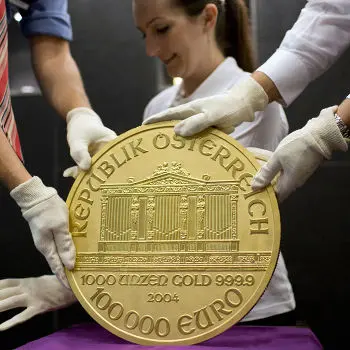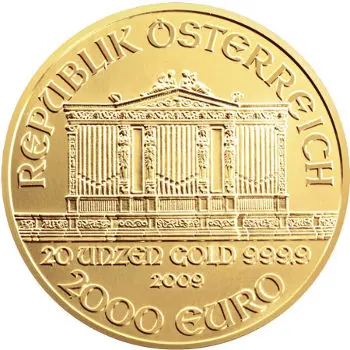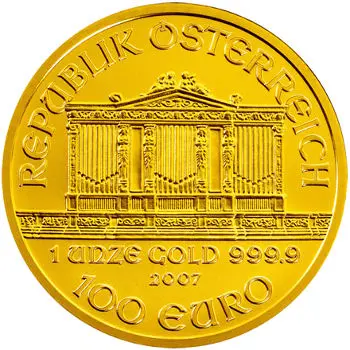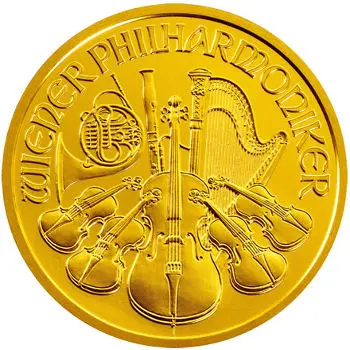One of Europe’s most popular gold bullion coins, and indeed one of the world’s most popular, is the Austrian Gold Philharmonic coin. Often referred to as the Vienna Philharmonic, or simply the Philharmonic, this gold bullion coin was first minted during an era when gold-producing nations around the world ramped up production of bullion coins following international sanctions on the Gold Krugerrand.
The gold Philharmonic is minted by the Austrian Mint, a facility that has been open since 1194. Duke Leopold VI of Austria commissioned the mint to produce coins from 15 tonnes of silver he had been paid by England’s Richard the Lionheart. Today, the Austrian Mint is one of the world’s finest facilities.
A Short History of the Austrian Gold Philharmonic
The Austrian Gold Philharmonic was first struck in 1989 and introduced in just two sizes: 1 ounce and ¼ ounce. In 1991, the coin series was expanded to include a 1/10 ounce coin. The series was further expanded in 1994 to include a 1/2 ounce coin. Since the introduction of the fourth coin weight, the Philharmonic has been struck in all four sizes and weights every year.
Beginning in 2014, the Austrian Mint added a 1/25 ounce gold Philharmonic coin to the lineup. The coin is designed to celebrate the 25th anniversary of the Philharmonic coin, but it is unknown if the Austrian Mint will continue production of the diminutive coin in the coming years. All Philharmonic coins are minted each year based upon market demand, meaning the popularity (and future production) of the 1/25 ounce coin remains unknown.
Unlike some of the competing gold bullion coins around the world, the Philharmonic coin underwent a change in face values in 2002 when the member-nations of the European Union adopted the Euro as their official currency. Prior to 2002, Philharmonic coins (as legal tender in Austria) had a face value of 2,000 schillings (AST) for the one ounce coin. With the adoption of the Euro in 2002, the face value was changed to €100 for the one ounce coin.
Gold Philharmonic Specifications
All Austrian Gold Philharmonic coins are struck in .9999 pure gold. The specifications for the five available coin sizes and weights are as follows:
- 1/25 Ounce (€4 Face Value)
- 13 mm diameter
- 1/10 Ounce(€10 Face Value)
- 16 mm diameter
- 1.2 mm thickness
- 1/4 Ounce (€25 Face Value)
- 22 mm diameter
- 1.2 mm thickness
- 1/2 Ounce (€50 Face Value)
- 28 mm diameter
- 1.6 mm thickness
- 1 Ounce (€100 Face Value)
- 37 mm diameter
- 2 mm thickness
Special Releases and Limited Edition Coins
The Austrian Mint has produced two special Austrian Gold Philharmonic coins since 1989. In 2004, the mint released a 1,000 ounce gold Philharmonic in honor of the coin’s 15th anniversary. Known as the “Big Phil,” this coin consisted of 31.103 kg of pure gold, had a diameter of 37 cm, a thickness of 2 cm, and had a nominal face value of €100,000. When it was struck, the Big Phil was one of the world’s largest coins with the highest denomination. The crown did not last for long though as the Royal Canadian Mint’s 100 kg Canadian Gold Maple Leaf was minted with a face value of $1,000,000 (CAD).

In 2009, the mint produced a 20 ounce Austrian Gold Philharmonic to celebrate the coin’s 20th anniversary. The 20th-anniversary coin was minted with a face value of €2,000, weight of 20 ounces, diameter of 74 mm, and a thickness of 8.3 mm. Although it was just minted in the recent past, the 20th-anniversary coin is one of the most difficult to find because the Austrian Mint limited production to a total of 6,027 coins. In a nod to the mint year, 2009, the Austrian Mint distributed the coins in three groups of 2,009 coins to the US, European, and Japanese markets.

Austrian Gold Philharmonic Coin Design
The obverse and reverse designs of the Austrian Gold Philharmonic coin have been the same since it was introduced in 1989. The images featured on each side pay homage to the musical history of the nation and call attention to the beauty of its music halls. Thomas Pessendorfer, the chief engraver of the Austrian Mint, is responsible for the design featured on both sides.
On the obverse side is an image depicting the pipe organ found at Vienna Musikverein’s Golden Hall. Engravings on this side of the coin include the weight, metal content, purity, and face value of the coin. Above the image of the pipe organ are the words; “Republik Osterreich.”

On the reverse side, a combination of instruments used by the Vienna Philharmonic is featured. The instruments included are the Vienna horn, bassoon, harp, four violins, and a cello. Additional engravings on this side include the phrase “Wiener Philharmoniker,” which translates to “Vienna Philharmonic” in English.

Buying Austrian Gold Philharmonic Coins
The Austrian Gold Philharmonic has long been one of the most popular gold bullion coins in the world, but its global profile skyrocketed during the global financial crisis of 2008. According to the World Gold Council, the Philharmonic led gold bullion sales worldwide in 1992, 1995, and 1996. In 2008, more 1 ounce Philharmonics were sold around the world than U.S. Eagles or Krugerrands.
The Austrian Mint determines mintage levels based upon market demand, meaning that consumers looking for coins from lower mintage years can expect difficulty in find those particular products. For example, the lowest annual mintage total came in 2001 as Austria transitioned into the European Union. The 2001 Austrian Gold Philharmonics are the final coins in the series to include face values in Austrian Schillings, and were produced at ¼ the level of coins from the previous year (2000).
Another difficult coin to find is the 20 oz gold coin minted for the coin’s 20th anniversary. Due to high market prices at the time and limited minting, the 20 oz coins were sold at 10% above gold prices. Today, these remain one of the more difficult Philharmonic coins to find.
Where To Buy Online
The best place to search for Austrian Gold Philharmonic coins online is with reliable, certified vendors such as APMEX, BGASC, JM Bullion, Modern Coin Mart, Provident Metals or SD Bullion. These vendors not only have hard-to-find coins in stock, but provide secure online sales and usually they have very competitive pricing.


